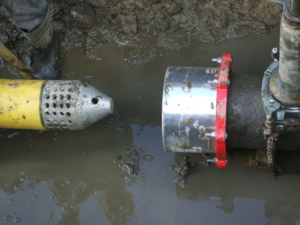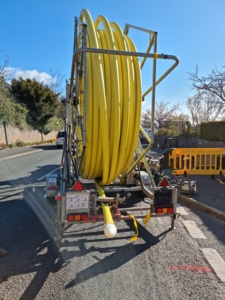news
Steve Vick Products Improve Efficiency and Health and Safety When Used in Conjunction with Pipeline Replacement Techniques
June 6, 2022
Steve Vick International pioneered Live Mains Insertion (LMI) back in 1981, a pipeline replacement technique which maintains gas supplies to customers during the insertion process. The technique is still widely used by Gas Distribution Networks (GDNs) today and renowned for reducing customer ‘off-gas’ times and promotes safe working best practice.
Live Mains Insertion is similar to normal insertion of polyethylene pipe (PE) into an existing metallic main with one important difference. By using a special gland box and a live head on the PE, the old main is kept live throughout the insertion process and the new PE is gassed up to maintain supplies to customers.
Once insertion is complete, the main is kept live to supply customers with gas via the annular space until it is operationally convenient to transfer the services to the new PE main.
As part of the development of this technique several innovative products were designed. As mentioned, the Lyontec gland box for example is a fitting that fixes onto the end of the metallic main and houses special glanding which allows the PE to be inserted but prevents gas escape. This is key to keeping the feed live whilst the pipeline is replaced. Another important innovation designed for LMI was the live head, a metal nosecone which screws into the leading end of the PE and allows gas to transfer from the host main into the coil or sticks of PE.
Both products have seen further development and innovation over the years. The gland box has been adapted for SVI’s latest foam technique, Foambag Operation on Stubs (FBOS). FBOS is a live mains replacement technique for 4-8” stubs that delivers 100% abandonment. FBOS uses two umbilicals, used to deliver expanding PU foam to fill the annular space between the host main and the PE, and the SVI gland box was adapted in order to allow these ubilicals to pass through without gas escaping. The SVI live head has also seen some evolution with a new electro fused Live Head now available. The internally electro fused Live Head offers a streamlined shape with the Live Head sitting flush with the PE. This allows for easy insertion into a 4” main and makes negotiating bends less challenging. The new PE head can also be used on up to 8” mains.
Following the development of LMI, SVI identified further products to help GDN’s become more efficient and improve health and safety for both the general public and their engineers. Commonly used on an LMI or FBOS project is SVI’s range of Pipe Handlers and Pipe Coil Trailers. SVI’s Pipe Handlers which can insert and manoeuvre pipe from 40mm up to 900mm, offer a safer alternative to using an excavator bucket and sling to insert the pipe and
helps to avoid the need for operators to work in the trench. The SVI Pipe Handlers offer fast insertion speeds of approximately 5-10 metres per minute, with their Perpetual Pipe Pusher achieving pushing speeds of 25 metres per minute.
 Steve Vick offers a range of Pipe Coil Trailers that work well in unison with their Pipe Handlers and these can often be seen on site at FBOS and LMI projects. All SVI trailers have been designed and engineered with the optimum safety of the operator in mind. The Hexi Trailer has the facility to hydraulically raise and lower the retaining bars and the safe access to remove the bands means that this trailer is much safer than the alternatives. The brakes on the Hexi Trailer also must be locked on before any other element can be altered and the pipe can be jacked up inside the trailer, to a point whereby it is dispensed slightly downhill directly from the carousel, instead of being dragged over a set of rollers which makes dispensing effortless and eliminates the need for uncontrolled operative intervention. Another significant benefit of the Hexi Trailer is that it offers a safe way to transport and store coiled PE, which helps to reduce pipe wastage. By using 500m coils for example, useful lengths can be left on the trailer for the next job. This has been proven to reduce pipe wastage by up to 20%.
Steve Vick offers a range of Pipe Coil Trailers that work well in unison with their Pipe Handlers and these can often be seen on site at FBOS and LMI projects. All SVI trailers have been designed and engineered with the optimum safety of the operator in mind. The Hexi Trailer has the facility to hydraulically raise and lower the retaining bars and the safe access to remove the bands means that this trailer is much safer than the alternatives. The brakes on the Hexi Trailer also must be locked on before any other element can be altered and the pipe can be jacked up inside the trailer, to a point whereby it is dispensed slightly downhill directly from the carousel, instead of being dragged over a set of rollers which makes dispensing effortless and eliminates the need for uncontrolled operative intervention. Another significant benefit of the Hexi Trailer is that it offers a safe way to transport and store coiled PE, which helps to reduce pipe wastage. By using 500m coils for example, useful lengths can be left on the trailer for the next job. This has been proven to reduce pipe wastage by up to 20%.
On LMI or dead inserted projects, SVI Rapid Rotary Cutters are often used as a preparation tool on ductile and steel mains. This includes the cut to allow ‘bagging-off’ a main in preparation of installing a Gland Box, or each time an Insertion Seal or Live End Seal is installed when decommissioning a section of main in order to transfer the services to the new PE gas main. SVI’s Rapid Rotary Cutters circumferentially cut steel, ductile or cast-iron mains up to 300mm/12” in diameter. They have a quick cutting time, approximately 2 minutes per cut on 4”/100mm ductile iron and 4 minutes per cut on 4”/100mm steel. They offer a safer alternative to more traditional methods of cutting pipe, such as Stihl saws and the cutting blade is mounted away from the operator’s hand.
When transferring the services to the new PE main an SVI Rapid Window Cutter can be used to cut access windows at each service Top Tee location for the new service connection to be made to the gas main. SVI’s Rapid Window Cutters are a compact, hand-held cutter for cutting windows in live or dead inserted mains, without risking damage to the inserted PE. They are suitable for all sizes of steel and ductile mains up to 13mm in depth. They also have the cutting disc mounted well away from the operator’s hand and have an automatic emergency cut-off on the trigger handle.
